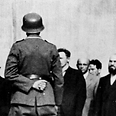
Shavli Ghetto Jews being led to their death (archives)
Photo courtesy of Yad Vashem
Even after decades of in-depth Holocaust research, excruciating details are only now emerging about more than 1,100 German-run ghettos in Eastern Europe where the Nazis murdered hundreds of thousands of Jews.
Holocaust Remembrance Day
Yitzhak Benhorin, agencies
US president places candle in Hall of Remembrance, says 'when efforts are made to equate Zionism to racism, we reject them'
And there were about 200 more ghettos than previously believed, said Martin Dean, editor of the recently published "Encyclopedia of Camps and Ghettos, 1933-1945, Volume II." It's part of a long-term effort to document every site of organized Nazi persecution, beyond the well-known Warsaw ghetto and extermination camps like Auschwitz.
It "gives us information about ghettos that would slip into historical oblivion and be forgotten forever if we didn't have this volume," Holocaust scholar Lawrence Langer said. "Who knew there were more than 1,000 ghettos?"
More Jews died during World War II in Poland and the western Soviet Union — today's Ukraine, Belarus and Lithuania — than the estimated 1 million gassed in Auschwitz, Langer said.
"The people are dead, but at least we have the memory of the place where they lived and some knowledge of who killed them," said Langer, an 83-year-old professor of English emeritus at Boston's Simmons College.
The museum fields inquiries daily about survivors' families using the new information — some of it from non-Jews divulging locations of unmarked mass graves.
'300-year-old town ceased to exist'
Researchers at the US Holocaust Memorial Museum in Washington painstakingly collected details for the encyclopedia's more than 2,000 pages from the communities where Germans herded Jews and killed them if they tried to escape.
Researchers and writers scoured the world to find new witnesses, study archives opened after the fall of communism and survivors' texts and testimonies in many languages.
For town after town, village after village, and even just spots in the countryside, Dean and his team assembled pieces of a grisly puzzle, which he said "shows that the Nazis made a concerted effort to find every last Jew in every last place" and eliminate each one.
Dean is a Holocaust scholar at the museum's Center for Advanced Holocaust Studies and former senior historian for the Nazi War Crimes Investigation Unit at Scotland Yard in London.
One tiny town in Ukraine, Mizocz, reflects the horrors repeated over and over across Eastern Europe. Its entry was written by a survivor who now lives in Pennsylvania and one of fewer than 10 percent of Eastern European ghetto dwellers who survived the war.
Helen Segall, now 81, was 11 when she witnessed SS troops torch her town of about 2,000 residents, with hundreds of hidden Jews burned to death before they could escape. Others were killed outside the town.
"People had to undress and walk in small groups into the trench and lie face down, where they were shot by an SS man helped by a Ukrainian Schutzmann," she wrote, using a German word for local policeman.
In two days — Oct. 13 and 14, 1942 — the 300-year-old town "ceased to exist," wrote Segall, who is now writing her own memoir.
She also wrote an encyclopedia entry for Dubno, her Polish birthplace where her father and two brothers were dragged from their home and murdered in the local cemetery. The ghetto was established there on the first day of Passover in 1942.
Hunger and diseases took their toll, she wrote, and on a lilac-scented May day, a deep ditch was dug nearby. SS troops armed with whips and dogs rounded up the elderly or ill and shot them to death. The rest were forced to work for the Germans in factories and construction, and on the railroad.
Some of the Jews who lived in the Polish city of Krakow were helped by Oskar Schindler during the liquidation of the ghetto there, later working in the enamel factory portrayed in the film "Schindler's List."
Another encyclopedia on World War II ghettos was published in 2009 by Yad Vashem in Jerusalem, Israel's official memorial to Holocaust victims. The "Encyclopedia of the Ghettos" sums up the story of each ghetto for either lay readers or researchers.
The two-part tome compiled by the US Holocaust museum and published in early May by Indiana University Press includes more listings, with extensive scholarly footnotes and bibliographies.
The two projects "are complementary," says Dan Michman, the head of Yad Vashem's Institute for Holocaust Research who wrote the introduction to its encyclopedia.
The rest of the seven-volume US project is expected to be completed in the next decade, tracking more than 20,000 sites of wartime persecution of both Jews and non-Jews.
The new volume covers ghettos from Moscow to today's German border, and St. Petersburg to Yalta, in Ukraine.
The next volume will cover camps and ghettos run by states aligned with Nazi Germany like Vichy France, Romania, Bulgaria, Hungary, Slovakia, Italy and Croatia.















